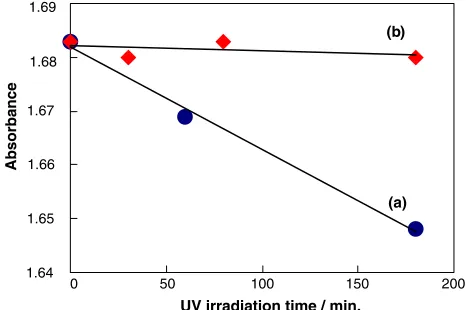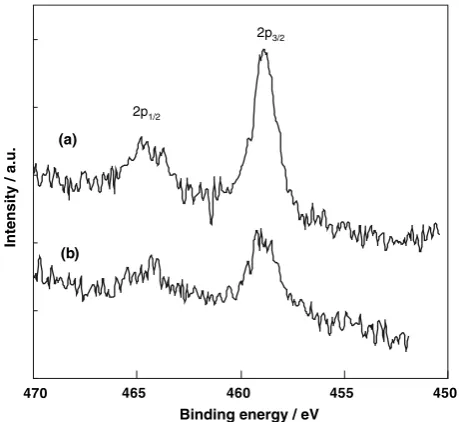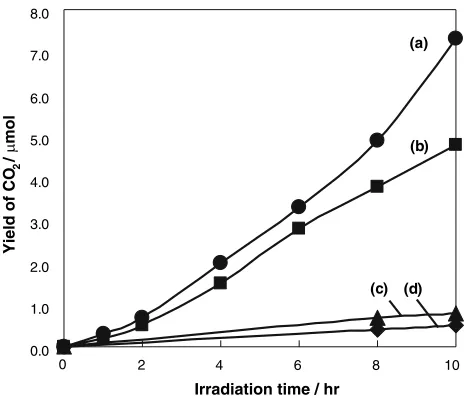O R I G I N A L P A P E R
Photocatalytic Decomposition of Lactic Acid in Water
on a Photoelectrochemical Circuit System Consisting
of a Rod-type TiO
2Electrode and Silicon Solar Cell
Masaya MatsuokaÆ Takashi KamegawaÆDiana RakhmawatyÆ
Masaaki KitanoÆKiyohisa WadaÆMasakazu Anpo
Published online: 25 March 2008
ÓSpringer Science+Business Media, LLC 2008
Abstract Lactic acid, a well-known substance causing dental caries, was dissolved in water and completely oxi-dized into CO2and H2O on a powdered TiO2photocatalyst under UV light irradiation. Furthermore, a unique photo-electrochemical circuit system consisting of a rod-type TiO2electrode and counter electrode connected through a silicon solar cell was constructed and its photocatalytic activity for the decomposition of lactic acid was investi-gated. The photoelectrochemical circuit system was found to effectively mineralize the lactic acid in water into CO2 while the negative bias applied on the rod-type TiO2 electrode enhanced the photocatalytic decomposition rate of the lactic acid.
Keywords PhotocatalysisSilicon solar cell
Lactic acid
1 Introduction
Photocatalysis has attracted a great deal of attention as an environmentally harmonious catalytic process that can reduce toxic agents diluted in air and water under UV or solar light irradiation. In fact, semiconducting TiO2 phot-ocatalysts have been practically applied for various
reactions such as the decomposition of NOxin air [1,2] and the degradation of toxic organic impurities diluted in water [3–10]. Studies on the dynamics and mechanisms behind such photocatalytic reactions have shown that the electrons and holes produced by UV irradiation of semiconducting TiO2 play a significant role in the formation of an active intermediate species such as O2-, OH, H, etc., depending on the reaction conditions [9, 10]. Photoelectrochemical investigations have also elucidated that the photocatalytic reaction rates on TiO2 electrodes as well as the reaction dynamics of the photo-formed electrons and holes are sig-nificantly affected by the external electric bias applied on the TiO2electrodes. In the present work, the photocatalytic decomposition of lactic acid in water on powdered TiO2 photocatalysts have been investigated for practical appli-cations of TiO2photocatalysts in dental care. Lactic acid, which exists abundantly in the human buccal or oral cavity, is the cause of dental caries so that the effective and efficient elimination of lactic acid is essential in cavity protection [11,12]. In the present work, a unique photoelectrochemi-cal circuit system was constructed by connecting a rod-type TiO2electrode with a counter electrode through an silicon solar cell (SSC) and its photocatalytic activity for the decomposition of lactic acid in water was investigated. The effect of the applied external bias on the photocatalytic decomposition rate of lactic acid for the photoelectro-chemical circuit system was also investigated.
2 Experimental
Powdered TiO2 was supplied by the Catalysis Society of Japan as a standard reference catalyst (JRC-TiO-4: P-25, surface area: 50 m2/g). The rod-type TiO2electrode was prepared by the calcination of a metal Ti rod
M. MatsuokaT. KamegawaD. RakhmawatyM. Kitano M. Anpo (&)
Department of Applied Chemistry, Graduate School of Engineering, Osaka Prefecture University,
1-1 Gakuen-cho, Naka-ku, Sakai, Osaka 599-8531, Japan e-mail: [email protected]
K. Wada
Shiken Corporation, 2-5-6 Terada-cho, Tennoji-ku, Osaka 534-0045, Japan
123
(/ 3 mm978 mm) at 1,073 K for 3 min in air. The photoelectrochemical circuit system was constructed by connecting the rod-type TiO2 electrode with a counter electrode through an SSC (2.4 V, 6lA: 200 lx). Photo-catalytic reactions were carried out by suspending the powdered TiO2 (10 mg) or immersing the photoelectro-chemical circuit system in an aqueous solution of lactic acid (20 mL) under light irradiation from various light sources such as a high-pressure mercury lamp (500 W) or a fluorescent lamp (20 W) at 298 K. The photoelectro-chemical current between the rod-type TiO2electrode and counter electrode was adjusted at 70lA by a variable resistor only for the pH measurement experiment. The reaction products were analyzed by gas chromatography (Shimadzu, GC-9A). The XPS spectra were recorded under vacuum at 298 K using an ESCA3200 (Shimadzu). The surface morphologies of the rod-type TiO2electrode were investigated by scanning electron microscopy (SEM, Hit-achi, S-4500).
3 Results and Discussion
3.1 Photocatalytic Decomposition of Lactic Acid in Water on Powdered TiO2Photocatalysts
An aqueous solution of lactic acid exhibited a UV absorption band at around 350 nm due to the lactic acid. As shown in Fig.1, UV irradiation of the lactic acid aqueous solution suspended with powdered TiO2led to an efficient decrease in the intensity of the UV absorption band at around 350 nm due to the lactic acid, suggesting that it is photocatalytically mineralized. In fact, as shown in Fig.2, UV irradiation of the aqueous solution of lactic acid
suspended with powdered TiO2led to the formation of CO2 with a good linearity against the UV irradiation time. The formation rate of CO2was around five times higher than that observed for the reaction conducted without TiO2, showing that the complete oxidation of lactic acid pro-ceeded photocatalytically. The formation of CO (16lmol), CH4(14lmol), and acetaldehyde (9 lmol) as by-products were observed after UV irradiation of 5 h (Fig.2), how-ever, their yields were negligible as compared to CO2. The complete oxidation of lactic acid in water was, thus, found to proceed efficiently on powdered TiO2 under UV light irradiation, showing that photocatalysis can be effectively applied for the safe removal of lactic acid in the human buccal cavity.
3.2 Characterization of the Rod-type TiO2Electrode and the Photocatalytic Activity of the
Photoelectrochemical Circuit System for the Decomposition of Lactic Acid in Water
In order to apply a TiO2 photocatalyst for the complete mineralization of lactic acid in the human buccal cavity, TiO2was first fixed onto a substrate. In the present work, the rod-type TiO2electrode was prepared by calcination of a metal Ti rod (/3 mm978 mm) at 1,073 K for 3 min in air. This rod-type TiO2electrode had already been applied for toothbrushes (Soladey 3; Shiken Corp.) equipped with an SSC (2.4 V, 6lA) and counter electrode. Scheme1 shows a schematic diagram of the electric circuit of So-ladey 3 which consists of a rod-type TiO2 electrode and metal counter electrode connected through an SSC where a negative bias is applied on the rod-type TiO2electrode by the SSC. The rod-type TiO2electrode was characterized by SEM and XPS investigations. Figure3 shows the Ti 2p XPS spectra of the rod-type TiO2electrode and metal Ti
1.67
UV irradiation time / min.
Absorbance
Fig. 1 Time dependences of the intensity of the absorption band
(k=350 nm) of lactic acid in water in the (a) presence and (b) absence of powdered TiO2(P-25) under UV irradiation (full arc). Light source: 500 W high-pressure mercury lamp. Concentration of lactic acid: 0.01 M
0
Yield of CO
2
acetaldehyde /
µ
mol
Fig. 2 Time dependences of the yields of: (a, e) CO2, (b) CO, (c)
CH4, and (d) acetaldehyde from an aqueous solution of lactic acid in: (a–d) the presence and (e) the absence of powdered TiO2(P-25) under UV irradiation (full arc). Light source: 500 W high-pressure mercury lamp. Concentration of lactic acid: 1.0 M
Top Catal (2008) 47:162–165 163
rod before calcination. Both samples show typical XPS peaks due to the TiO2 (Ti 2p3/2: 458.5 eV, Ti 2p1/2: 464.2 eV), suggesting that the surfaces of the rod-type TiO2electrode and metal Ti rod are covered with a stoi-chiometric TiO2 layer [13,14]. Figure4 shows the SEM images of the rod-type TiO2electrode and metal Ti rod. The metal Ti rod exhibits a rather flat surface while the rod-type TiO2 electrode exhibits a rough surface struc-ture covered with TiO2 crystallites with particle sizes of 300–700 nm, a desirable catalytic surface morphology enabling facile diffusions of the photo-formed electrons
and holes from the deep inside bulk to the TiO2electrode surface where the photocatalytic reactions proceed.
The photocatalytic activity of the rod-type TiO2 elec-trode (TE) has been investigated and, here, it was connected with a rod-type stainless steel electrode (SSE:/ 3 mm978 mm) through an SSC in the same sequence as depicted in Scheme 1. The constructed photoelectrochem-ical circuit system (denoted TE-SSC-SSE) was immersed in an aqueous solution containing lactic acid and K2SO4. Both the TE and SSC were then irradiated by a fluorescent lamp (20 W). Figure5 shows the time dependence of the pH of the lactic acid aqueous solution with the TE-SSC-SSE system. Light irradiation of the TE-SSC-TE-SSC-SSE system led to an increase in the pH of the solution, indicating that the lactic acid is efficiently decomposed by this system under light irradiation. The same experiment was con-ducted with a SSE-SSC-SSE system composed of two SSEs connected through SSC. As shown in Fig. 5, an increase in the pH of the aqueous solution was observed for the SSE-SSC-SSE system, while a much more significant pH increase was observed for the TE-SSC-SSE system. These results suggest that lactic acid can be electrochem-ically decomposed on a SSE-SSC-SSE system while the decomposition rate is significantly enhanced when using TE as the photoelectrochemically active electrode instead of SSE. It should be noted that only a negligible change in the pH can be observed under light irradiation when no photoelectrochemical circuit system was immersed in an aqueous solution of lactic acid. Figure6 shows the time dependences of the yields of CO2from aqueous solutions of lactic acid (0.1 M) with various photoelectrochemical
Scheme 1 Schematic diagram of the electric circuit of a
commer-cially produced toothbrush (Soladey 3; Shiken Corp.)
0 5 4 5
5 4 0
6 4 5
6 4 0
7 4
Binding energy / eV
Intensity / a.u.
) a (
) b (
p
2 1/2
p
23/2
Fig. 3 XPS spectra of the Ti 2p3/2and 2p1/2peaks of: (a) a rod-type
TiO2electrode and (b) a metal Ti rod
Fig. 4 SEM images of: (a) a rod-type TiO2electrode and (b) a metal
Ti rod
5 6 7 8 9
10 8
6 4
2 0
pH
) a (
) b (
) c (
Irradiation time / min.
Fig. 5 Time dependences of the pH of aqueous solutions of lactic
acid with: (a) TE-SSC-SSE, (b) SSE-SSC-SSE, and (c) without any photoelectrochemical circuit system under light irradiation. Initial pH value was adjusted at 5.7 by adding a NaOH aqueous solution. Composition of aqueous solution: lactic acid (0.001 M), K2SO4 (0.3 M). Light source: 20 W fluorescent lamp
164 Top Catal (2008) 47:162–165
systems under light irradiation with a fluorescence lamp. Light irradiation of the TE-SSC-SSE system led to the efficient formation of CO2, confirming that the lactic acid can be decomposed with this system. The CO2 evolution rate on the TE-SSC-SSE system was found to be higher than that on the SSE-SSC-SSE system, suggesting that the decomposition rate of lactic acid can be significantly increased by using TE as a photochemically active elec-trode instead of SSE. Moreover, the negligible formation of CO2 was observed on the TE-SSE system where TE is directly connected to SSE, showing that an external neg-ative potential applied on TE by SSC plays an important role in increasing the photocatalytic activity of the TE-SSC-SSE system. Only a negligible formation of CO2 was observed under light irradiation when no photoelect-rochemical circuit system was immersed in the aqueous solution of lactic acid. From these findings, it could be concluded that the TE-SSC-SSE system can be practically applied for the clean and safe removal of lactic acid in the human buccal cavity. Further investigations on the detailed mechanisms behind the decomposition of lactic acid on photoelectrochemical circuit systems are now underway.
4 Conclusions
It was found that the complete oxidation of lactic acid in water into CO2 proceeds efficiently on powdered TiO2 photocatalyst under UV light irradiation. Negligible for-mations of by-products such as CO, methane and acetaldehyde were also observed. A unique photoelectro-chemical system, i.e., TE-SSC-SSE, was constructed with a rod-type TiO2 covered with stoichiometric crystallites of TiO2 having particle sizes of 300–700 nm. Light irradia-tion of this TE-SSC-SSE system led to the efficient mineralization of the lactic acid in water into CO2, sug-gesting that the TE-SSC-SSE system can be practically applied for the safe removal of lactic acid in the human buccal cavity. Furthermore, it was shown that a negative bias applied on the rod-type TiO2 electrode by an SSC enhances the decomposition rate of the lactic acid in water.
References
1. Anpo M (2000) In: Tundo P, Anastas P (eds) Green chemistry. Oxford University Press, p 1
2. Anpo M (2000) In: Corma A, Melo FV, Mendioroz S, Fierro JLG (eds) Stud. Surf. Sci. Catal., vol. 130, A, Proc. 12th. Intern. Congr. Catal. (Granada), p 157
3. Ollis DF, AlEkabi H (eds) (1993) Photocatalytic purification and treatment of water and air. Elsevier
4. Pelizzetti E, Schiavello M (eds) (1991) Photochemical conver-sion and storage of solar energy. Kluwer Academic Publishers 5. Yamashita H, Harada M, Misaka J, Takeuchi M, Neppolian B,
Anpo M (2003) Catal Today 84:191
6. Harada M, Honda M, Yamashita H, Anpo M (1999) Res Chem Intermed 25:757
7. Harada H, Sakata T, Ueda T (1985) J Am Chem Soc 107:1773 8. Awatani T, Dobson KD, McQuillan AJ, Ohtani B, Uosaki K
(1998) Chem Lett 849
9. Anpo M (1997) Catal Surv Japan 1:169 and references therein 10. Anpo M, Kubokawa Y (1987) Res Chem Intermed 8:105 11. Yamamoto T, Sato T, Nishida Y, Nishikawa R, Negishi K,
Ueshiro M, Niwa M (1989) J Dental Health 38:564
12. Onoda K, Matsushita K, Nakagawa Y, Izumi I (1987) Denki Kagaku 55:946
13. Erdem B, Hunsicker RA, Simmons GW, Sudol ED, Dimonie VL, El-Aasser MS (2001) Langmuir 17:2664
14. Kitano M, Funatsu K, Matsuoka M, Ueshima M, Anpo M (2007) J Phys Chem B 110:25266
0.0 1.0 2.0 3.0 4.0 5.0 6.0 7.0 8.0
0 2 4 6 8 10
Yield of CO
2
/
µ
mol
) a (
) b (
) c ( (d)
Irradiation time / hr
Fig. 6 Time dependences of the yields of CO2 from aqueous
solutions of lactic acid (0.1 M) with: (a) TE-SSC-SSE, (b) SSE-SSC-SSE, (c) TE-SSE, and (d) without any photoelectrochemical circuit system under light irradiation. Composition of aqueous solution: lactic acid (0.1 M), K2SO4 (0.3 M). Light source: 20 W fluorescent lamp
Top Catal (2008) 47:162–165 165


